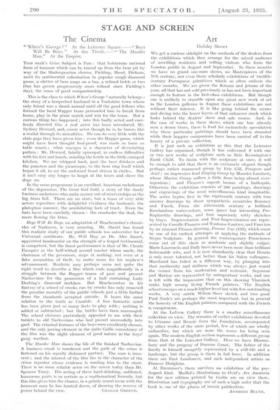Art
Holiday Shows WE get a curious sidelight on the methods of the dealers from the exhibitions which they arrange for the mixed audience of unwilling residents and willing visitors who form the London public in August and September. In these months we have no grand one-man shows, no Masterpieces of the Nth century, nor even those scholarly exhibitions of twelfth- century Portuguese primitives which so often enliven the other months. We are given the flotsam and jetsam of the year, all that has not sold previously or has not been important enough to feature in the first-class exhibitions. But though one is unlikely to stumble upon any great new work of art in the London galleries' in August these exhibitions are not without their interest. It is like going behind the scenes and diving into the lower layers of that unknown stock which lurks behind the dealers' show and sale rooms. And, in the case of works in these shows which one has already seen a dozen times, there is food for melancholy speculation why these particular paintings should have been stranded while their happier companions have been carried off to the luxury of a private collection.
It is just such an exhibition as this that the Leicester Gallery has organized, though it has enlivened it with one or two new works of sculpture such as Eric Kennington's Earth Child. To finish with the sculpture at once, it will be enough to add that there is an extremely elegant though perhaps rather mannered group by Eric Gill, Prospero and Arid ; an impressive lead Singing Group by Maurice Lambert, whose Marine Group suffers a little from being almost over- ingenious ; and Picasso's superb bronze of a harlequin.
Otherwise the exhibition consists of 200 paintings, drawings and engravings of the most miscellaneous kind imaginable. The series begins first in the eighteenth century with two sinister drawings by those sympathetic eccentrics Romney and Fuseli. From the nineteenth century a brilliant Rowlandson water-colour, some queer but interesting Pre- Raphaelite drawings, and four supremely witty sketches by Guys. Impressionism and Post-impressionism are Topic- sented by Camille Pissarro and Toulouse-Lautrec, and FallViSlik by an unusual Picasso drawing, Femme Nue (139), which roust be one of his earliest attempts at applying the methods of Negro Sculpture. In general the contemporary Frenchmen come out of this show as academic and slightly vulgar. Marie Laurenein -and Day have never been more than brilliant fashionable wits, and it is now abundantly clear that Derain is only more talented, not better than his Salon colleagues. Marchand has failed in a different way, by plunging into that mediocrity and dullness which was always just round the corner from his moderation and restraint. Segonzae and Matisse are represented by unimportant works, and one is left with the impression that on this showing Vlaminck
French painters. The English ranks high among living school emerges on a much higher level but with few outstanding works. A very subtle Wilson Steer sketch and two good Paul Nash's are perhaps the most important, but in general the honesty of the English painters compared with the French is conspicuous.
At the Lefevre Gallery there is a smaller miscellaneous collection on view. The remains of earlier exhibitions devoted to Cezanne and Renoir form the foundation, accompanied by other works of the same period, few of which are wholly unfamiliar, but which are none the worse for being seen again. The modern English section represents a different group from that at the Leicester Gallery. Here we have Blooms- bury and the progeny of Duncan Grant. The father of the family is himself meagrely represented by a still-life and a landscape, but the group is there in full- force. In addition there are East Londoners, and such independent artists as Frances HOdgkins.
At Zwemmer's there survives an exhibition of the pre- August kind. Maillol's illustrations to Ovid's Ars Amaloria
for the new edition printed by Godin are on view there. Illustration and typography are of such a high order that the book is one of the plums of 'recent publication.
ANTHONY BLUNT. '


































 Previous page
Previous page